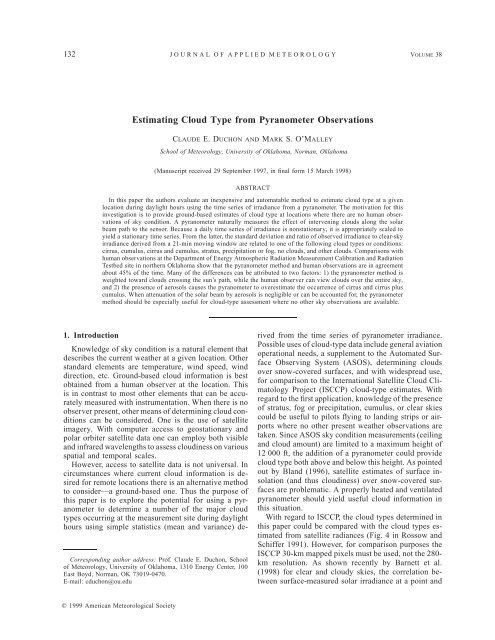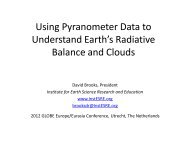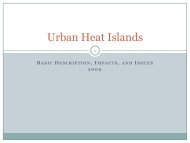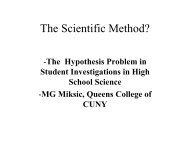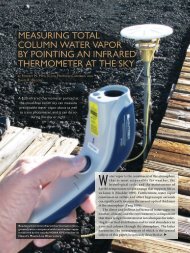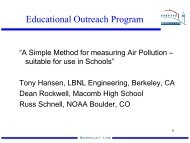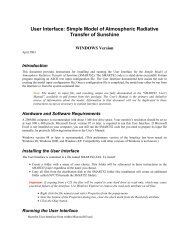Estimating Cloud Type from Pyranometer Observations - American ...
Estimating Cloud Type from Pyranometer Observations - American ...
Estimating Cloud Type from Pyranometer Observations - American ...
Create successful ePaper yourself
Turn your PDF publications into a flip-book with our unique Google optimized e-Paper software.
132 JOURNAL OF APPLIED METEOROLOGY<br />
VOLUME 38<br />
<strong>Estimating</strong> <strong>Cloud</strong> <strong>Type</strong> <strong>from</strong> <strong>Pyranometer</strong> <strong>Observations</strong><br />
CLAUDE E. DUCHON AND MARK S. O’MALLEY<br />
School of Meteorology, University of Oklahoma, Norman, Oklahoma<br />
(Manuscript received 29 September 1997, in final form 15 March 1998)<br />
ABSTRACT<br />
In this paper the authors evaluate an inexpensive and automatable method to estimate cloud type at a given<br />
location during daylight hours using the time series of irradiance <strong>from</strong> a pyranometer. The motivation for this<br />
investigation is to provide ground-based estimates of cloud type at locations where there are no human observations<br />
of sky condition. A pyranometer naturally measures the effect of intervening clouds along the solar<br />
beam path to the sensor. Because a daily time series of irradiance is nonstationary, it is appropriately scaled to<br />
yield a stationary time series. From the latter, the standard deviation and ratio of observed irradiance to clear-sky<br />
irradiance derived <strong>from</strong> a 21-min moving window are related to one of the following cloud types or conditions:<br />
cirrus, cumulus, cirrus and cumulus, stratus, precipitation or fog, no clouds, and other clouds. Comparisons with<br />
human observations at the Department of Energy Atmospheric Radiation Measurement Calibration and Radiation<br />
Testbed site in northern Oklahoma show that the pyranometer method and human observations are in agreement<br />
about 45% of the time. Many of the differences can be attributed to two factors: 1) the pyranometer method is<br />
weighted toward clouds crossing the sun’s path, while the human observer can view clouds over the entire sky,<br />
and 2) the presence of aerosols causes the pyranometer to overestimate the occurrence of cirrus and cirrus plus<br />
cumulus. When attenuation of the solar beam by aerosols is negligible or can be accounted for, the pyranometer<br />
method should be especially useful for cloud-type assessment where no other sky observations are available.<br />
1. Introduction<br />
Knowledge of sky condition is a natural element that<br />
describes the current weather at a given location. Other<br />
standard elements are temperature, wind speed, wind<br />
direction, etc. Ground-based cloud information is best<br />
obtained <strong>from</strong> a human observer at the location. This<br />
is in contrast to most other elements that can be accurately<br />
measured with instrumentation. When there is no<br />
observer present, other means of determining cloud conditions<br />
can be considered. One is the use of satellite<br />
imagery. With computer access to geostationary and<br />
polar orbiter satellite data one can employ both visible<br />
and infrared wavelengths to assess cloudiness on various<br />
spatial and temporal scales.<br />
However, access to satellite data is not universal. In<br />
circumstances where current cloud information is desired<br />
for remote locations there is an alternative method<br />
to consider—a ground-based one. Thus the purpose of<br />
this paper is to explore the potential for using a pyranometer<br />
to determine a number of the major cloud<br />
types occurring at the measurement site during daylight<br />
hours using simple statistics (mean and variance) de-<br />
Corresponding author address: Prof. Claude E. Duchon, School<br />
of Meteorology, University of Oklahoma, 1310 Energy Center, 100<br />
East Boyd, Norman, OK 73019-0470.<br />
E-mail: cduchon@ou.edu<br />
rived <strong>from</strong> the time series of pyranometer irradiance.<br />
Possible uses of cloud-type data include general aviation<br />
operational needs, a supplement to the Automated Surface<br />
Observing System (ASOS), determining clouds<br />
over snow-covered surfaces, and with widespread use,<br />
for comparison to the International Satellite <strong>Cloud</strong> Climatology<br />
Project (ISCCP) cloud-type estimates. With<br />
regard to the first application, knowledge of the presence<br />
of stratus, fog or precipitation, cumulus, or clear skies<br />
could be useful to pilots flying to landing strips or airports<br />
where no other present weather observations are<br />
taken. Since ASOS sky condition measurements (ceiling<br />
and cloud amount) are limited to a maximum height of<br />
12 000 ft, the addition of a pyranometer could provide<br />
cloud type both above and below this height. As pointed<br />
out by Bland (1996), satellite estimates of surface insolation<br />
(and thus cloudiness) over snow-covered surfaces<br />
are problematic. A properly heated and ventilated<br />
pyranometer should yield useful cloud information in<br />
this situation.<br />
With regard to ISCCP, the cloud types determined in<br />
this paper could be compared with the cloud types estimated<br />
<strong>from</strong> satellite radiances (Fig. 4 in Rossow and<br />
Schiffer 1991). However, for comparison purposes the<br />
ISCCP 30-km mapped pixels must be used, not the 280-<br />
km resolution. As shown recently by Barnett et al.<br />
(1998) for clear and cloudy skies, the correlation between<br />
surface-measured solar irradiance at a point and<br />
1999 <strong>American</strong> Meteorological Society
JANUARY 1999 DUCHON AND O’MALLEY<br />
133<br />
FIG. 1. The basis for using a pyranometer to estimate cloud type<br />
is that the clouds cross the solar beam impinging on the sensor, thus<br />
providing a time series of global irradiance fluctuations due to clouds.<br />
the average irradiance of surrounding stations is about<br />
0.9 (80% variance in common) for an area within a 30-<br />
km radius and decreases rapidly as the radius increases.<br />
The average station spacing in the Oklahoma Mesonet<br />
(Brock et al. 1995) is between 30 and 35 km (the data<br />
source <strong>from</strong> which Barnett et al. 1998 performed their<br />
analysis) so that an interesting study comparing ISCCP<br />
and pyranometer cloud-type estimates might be performed.<br />
It seems obvious at the outset that the inclusion of<br />
other atmospheric radiation measurements such as diffuse,<br />
direct, and atmospheric soundings can only improve<br />
the estimation of cloud type derived <strong>from</strong> a single<br />
instrument. However, the additional instrumentation is<br />
available only at a few locations, for example, the Department<br />
of Energy Atmospheric Radiation Measurement<br />
(ARM) sites in Oklahoma, Alaska, and the southwest<br />
Pacific. Our interest here is predicated on taking<br />
advantage of the good accuracy, simplicity, low cost,<br />
robustness, and minimum maintenance associated with<br />
state-of-the-art pyranometers.<br />
The outline of the remainder of the paper is as follows:<br />
section 2 provides the basis for using a pyranometer<br />
to estimate cloud type, section 3 discusses the irradiance-based<br />
classification method, section 4 describes<br />
the clear-sky irradiance model for standardizing<br />
irradiance measurements, and sections 5 and 6 compare<br />
irradiance-based cloud-type estimates with human observations<br />
of cloud type. A summary and conclusions<br />
are given in section 7.<br />
2. <strong>Pyranometer</strong> response to clouds<br />
A pyranometer measures the hemispheric broadband<br />
solar radiation available to drive the daytime surface<br />
energy budget. These measurements naturally integrate<br />
the effects of clouds. The concept of using a pyranometer<br />
to estimate cloud type is illustrated in Fig. 1 in<br />
which comparatively fast-moving clouds cross the slowmoving<br />
path of the solar beam. For cloud bases at 1 km<br />
the speed of the solar beam varies <strong>from</strong> 0.07 overhead<br />
FIG. 2. Comparison of diffuse and global irradiance for (a) a clear<br />
day, (b) a partly cloudy day, and (c) a mostly cloudy day at Norman,<br />
OK, for 12 July, 5 August, and 11 September 1995, respectively.<br />
to 2.4 m s 1 at a zenith angle of 80, while at a cloud<br />
base of 10 km, the comparable speeds are 0.7 and 24.1<br />
ms 1 . Because of the secant squared dependence on<br />
zenith angle, at very high cloud bases and large zenith<br />
there will be times when the cloud speed is similar to<br />
the speed of the solar beam.<br />
With clear skies the irradiance signal is dominated by<br />
the solar beam. Diffuse irradiance is around 15% of the<br />
total irradiance (at least in the southern plains). With<br />
variable cloudiness, the signal fluctuates principally in<br />
response to the occurrence or nonoccurrence of clouds<br />
intersecting the path between the sun and the pyranometer.<br />
When clouds are present along the beam path, the<br />
diffuse radiation as a fraction of the signal increases and<br />
becomes nearly indistinguishable <strong>from</strong> the total irradiance<br />
in overcast skies. That is, as the irradiance signal<br />
decreases due to increasing cloud thickness in the beam<br />
path, a correspondingly larger fraction of the sky surrounding<br />
the beam path contributes to the irradiance<br />
signal. This is shown in Fig. 2 for a clear day, in which<br />
the diffuse irradiance is about 15% of the global irradiance;<br />
a partly cloudy day, where the diffuse to global<br />
ratio is variable but greater than 15%; and a mostly<br />
overcast day, where the global and diffuse irradiances<br />
are essentially equivalent. Note in Fig. 2 that frequent<br />
sampling is necessary to capture the rapid variations in<br />
irradiance. In our case, the instantaneous sampling rate<br />
is once per second; the samples are then averaged over<br />
1-min intervals to yield the data used in this study.<br />
In summary, the time series of irradiance captures the<br />
character of the cloudiness weighted toward the portion<br />
of the sky where the sun is located and provides the<br />
basis for estimating cloud type. Because the fluctuations<br />
due to clouds are in proportion to the clear-sky solar<br />
irradiance, which varies systematically during the<br />
course of a day, the resulting time series of irradiance
134 JOURNAL OF APPLIED METEOROLOGY<br />
VOLUME 38<br />
FIG. 3. Measured global irradiance and modeled clear-sky irradiance at<br />
Lamont, OK, for 31 March 1995. The data are 1-min averages.<br />
FIG. 4. The solid line is the 21-min running mean and the short<br />
dashed line is the 21-min running standard deviation of the observed<br />
irradiances in Fig. 3 after they are scaled. The long dashed line is<br />
the scaled modeled clear-sky irradiance.<br />
is nonstationary (see Fig. 2b). To make sense of the<br />
statistical analysis employed in the classification<br />
scheme, it is necessary to linearize the estimated clearsky<br />
and observed irradiances to remove the proportionality.<br />
Accordingly, the clear-sky irradiance at each minute<br />
of each day is scaled to a constant value, where the<br />
scaling function is similarly applied to the observed<br />
irradiance. The model for clear-sky irradiance is discussed<br />
in section 4.<br />
3. A two-parameter irradiance-based cloud-type<br />
classification scheme<br />
a. Obtaining the parameters<br />
The basis for our classification scheme is the premise<br />
that certain types of clouds have statistical properties<br />
that can be used to identify their occurrence. The seven<br />
cloud types and sky conditions that were selected are<br />
cumulus, cirrus, cirrus and cumulus, stratus, fog and/or<br />
precipitation, no clouds (clear sky), and ‘‘other’’ clouds.<br />
For simplicity, reference to cloud type in the sequel will<br />
include sky conditions.<br />
The first step in the scheme is to scale the modeled<br />
clear-sky irradiance discussed later to a constant value<br />
of 1400 W m 2 for each minute of each day. This value<br />
is somewhat greater than the solar constant and never<br />
would be exceeded on a cloudless day at any latitude.<br />
Because the clear-sky model depends on daily dewpoint<br />
and seasonal inputs, each day has a slightly different<br />
set of scale factors. The second step is to multiply the<br />
observed irradiances by the same set of scale factors.<br />
For example, if the measured irradiance were equal to<br />
50% of the clear-sky irradiance, the scaled measured<br />
irradiance would be 700 W m 2 . The third step is to<br />
compute the mean and standard deviation of the scaled<br />
measured irradiance in a 21-min moving window.<br />
Figure 3 shows the unscaled, unwindowed clear-sky<br />
model and measured irradiance for 31 March 1995. The<br />
pyranometer used throughout this study is a periodically<br />
calibrated Eppley Precision Spectral <strong>Pyranometer</strong> with<br />
a 1-s time constant (Eppley Laboratory, Inc. 1976). This<br />
type of pyranometer has been in use for over 20 years<br />
and comprises a thermopile, the upper set of junctions<br />
of which responds to the shortwave radiation, and a pair<br />
of protective concentric hemispheres of Schott optical<br />
glass. The voltage output <strong>from</strong> the thermopile is proportional<br />
to the hemispheric irradiance. The pyranometer<br />
of interest is located at the ARM Southern Great<br />
Plains (SGP) Calibration and Radiation Testbed (CART)<br />
near the town of Lamont (Stokes and Schwartz 1994)<br />
in north-central Oklahoma. The solid line denotes consecutive<br />
1-min averages of 60 1-s instantaneous samples<br />
of irradiance. The character of the observed irradiance<br />
in Fig. 3 reveals that beginning at about 1630 UTC there<br />
is sufficient convection to initiate cumulus clouds,<br />
which last through much of the remainder of the day.<br />
Observed irradiance greater than clear-sky irradiance is<br />
a consequence of reflection <strong>from</strong> the sides of clouds.<br />
Application of scaling and smoothing to Fig. 3 results<br />
in the time series of the 21-min running means of 1-<br />
min-scaled measured irradiances and the corresponding<br />
standard deviations shown in Fig. 4 by the solid and<br />
short dashed lines, respectively. The rapid rise in standard<br />
deviation coincides with the development of cumulus<br />
clouds; simultaneously, the mean scaled irradiance<br />
decreases. The horizontal long dashed line is the<br />
scaled modeled clear-sky irradiance. The ratio of the<br />
running mean scaled irradiance to the scaled clear-sky<br />
irradiance and the running standard deviation of scaled<br />
observed irradiance in Fig. 4 are the two parameters<br />
used in the cloud-type decision criteria.<br />
It should be noted that the window width of 21 min<br />
was chosen empirically. A smaller window width, for<br />
example, 5 min, acts like a point-in-time measurement,
JANUARY 1999 DUCHON AND O’MALLEY<br />
135<br />
particularly if a single cloud element persists between<br />
the pyranometer and the direct beam for the entire span<br />
of the window width. A much larger window, say 50<br />
min, is also inappropriate because different cloud types<br />
may occur during this period of time. Based on experiments<br />
with various window lengths, 21 min appears to<br />
be a reasonable time span for estimating the mean and<br />
variance.<br />
b. Decision criteria<br />
Figure 5 shows the decision criteria for each of the<br />
seven cloud types. The determination of cloud-type<br />
boundaries is based primarily on a comparison of human-observed<br />
cloud types coincident with the measured<br />
irradiance parameters at the ARM CART site and secondarily<br />
on nominal values of the two parameters intuitively<br />
expected for the different categories based on<br />
the standard cloud-type descriptions. Thus the rectangular<br />
boundaries should not be considered as precise<br />
delineations.<br />
The lower-left-hand side of Fig. 5 contains stratus,<br />
precipitation, and fog. Here the attenuation of solar radiation<br />
is high, and the variability in the irradiance signal<br />
is small. The large area of cumulus is bounded on<br />
the left by a ratio of scaled observed to scaled clearsky<br />
irradiances of 0.5 and on the bottom by a standard<br />
deviation of scaled irradiance of about 120 W m 2 ,<br />
which is 20 W m 2 higher than the upper-stratus boundary.<br />
In addition, there must be at least one value of the<br />
21-min time series that has an irradiance greater than<br />
the clear-sky value, as is typical of cumulus clouds (see,<br />
for example, Fig. 3). This criterion was used to separate<br />
cumulus <strong>from</strong> cumulus and cirrus, the other large rectangle<br />
in Fig. 5. The argument is that cirrus added to<br />
cumulus lowers the general level of irradiance relative<br />
to clear-sky irradiance to such a value that the above<br />
criterion is not met. Nevertheless, the cumulus contribution<br />
continues to yield large variance.<br />
Cirrus occupies an area with the ratio of irradiances<br />
varying <strong>from</strong> 0.8 to 1.05. A ratio greater than unity is<br />
again due to scattering of the solar beam, this time by<br />
patchy cirrus clouds. The standard deviation is low because<br />
of the thinness of the clouds and limited attenuation. The<br />
clear-sky area is defined by an irradiance ratio extending<br />
<strong>from</strong> 0.88 to 1.05 and a standard deviation of scaled irradiance<br />
less than 10 W m 2 . The area outside specific<br />
cloud types represents clouds of indeterminate types.<br />
The seven cloud types are shown on the left-hand<br />
side of Table 1. On the right-hand side are the associated<br />
human observations considered acceptable as verification.<br />
In section 5 these relationships will be used to<br />
compare the objective cloud classification with the human<br />
observations for 1995.<br />
4. Clear-sky irradiance model<br />
a. Formulation<br />
<strong>Estimating</strong> clear-sky solar radiation is one of the primary<br />
ingredients of the pyranometer method. The model<br />
used here is that developed by Meyers and Dale (1983).<br />
The fundamental assumption in this model is that the<br />
formulas for transmission of solar radiation through the<br />
atmosphere as developed, for example, by Iqbal (1983),<br />
for a single wavelength, can be applied to the entire<br />
solar spectrum. In the absence of clouds, the surface<br />
irradiance I is given by<br />
I I 0 cos z T R T g T w T a , (1)<br />
where I 0 is the irradiance at the top of the atmosphere<br />
normal to the solar beam; z is the solar zenith angle;<br />
and the T i ’s are transmission coefficients for Rayleigh<br />
scattering (R): permanent gas absorption (g), water vapor<br />
absorption (w), and scattering by aerosols (a). Although<br />
(1) is generally valid for monochromatic radiation<br />
only, it has been widely used to represent broadband<br />
irradiance in the real atmosphere (Atwater and Ball<br />
1981). Here, I 0 varies according to time of year as given<br />
by Iqbal (1983). The solar zenith angle z is taken <strong>from</strong><br />
the standard expression given by List (1968, 497) and<br />
takes into account latitude, declination angle, and hour<br />
angle. The two angles are computed as a function of<br />
latitude, longitude, and day of year using an algorithm<br />
given by Michalsky (1988).<br />
The Rayleigh and permanent gas scattering and absorption<br />
transmission coefficients are taken <strong>from</strong> Kondratyev<br />
(1969) and Atwater and Brown (1974) and given<br />
by<br />
5 0.5<br />
TT R g 1.021 0.084[m(949p 10 0.051)] ,<br />
(2)<br />
where p is surface pressure (kPa) and m the optical<br />
airmass number at 101.3 kPa given by<br />
m 35(1224 cos 2 z 1) 0.5 . (3)<br />
The water vapor transmission coefficient is<br />
T w 1 0.077(um) 0.3 , (4)<br />
where u is precipitable water (cm) (McDonald 1960).<br />
Precipitable water is estimated <strong>from</strong> the surface dewpoint<br />
(Smith 1966) using<br />
u exp[0.1133 ln( 1) 0.0393T d ], (5)<br />
where T d is the local average daily dewpoint (F) and<br />
is an empirically derived constant based on season<br />
and latitude (Table 2.1 in Smith 1966). The aerosol<br />
transmission coefficient was determined by Meyers and<br />
Dale (1983) as a residual in clear-sky studies and is<br />
given by<br />
T a x m , (6)<br />
where x 0.935 was found to be nearly constant for<br />
continental midlatitude stations.<br />
b. Comparison with observations<br />
Figure 6 shows the percentage difference between<br />
modeled [Eq. (1)] and measured clear-sky irradiance<br />
given by
136 JOURNAL OF APPLIED METEOROLOGY<br />
VOLUME 38<br />
FIG. 5. Decision criteria for estimating cloud type based on the standard deviation of scaled observed<br />
irradiance and the ratio of scaled observed irradiance to scaled clear-sky irradiance. The data are 1-min cloudtype<br />
estimates for March 1995.<br />
percent difference<br />
(modeled measured) clear-sky irradiance<br />
100%<br />
measured clear-sky irradiance<br />
(7)<br />
for 12 clear-sky days at the central facility representing<br />
all seasons of the year. Five of the days contained haze<br />
and utilized a new empirically derived constant for high<br />
aerosol content as determined <strong>from</strong> visibility measurements<br />
and human observations (O’Malley 1996). We<br />
see that for zenith angles less than 70, the clear-sky<br />
model performs quite well (relative to measurements),<br />
capturing the measured clear-sky irradiance within approximately<br />
5%, except for a few traces. Beyond 70<br />
the differences increase, particularly on the negative<br />
side. The differences at large zenith angles may be attributable<br />
to a degraded pyranometer cosine response,<br />
model error, or both.<br />
Figure 7 shows the numerical differences between the<br />
TABLE 1. The human observations (right-hand side) considered<br />
acceptable as verification of the seven cloud types (left-hand side)<br />
derived <strong>from</strong> the pyranometer method.<br />
<strong>Cloud</strong> type defined by<br />
pyranometer method<br />
Clear sky<br />
Cirrus<br />
Cumulus<br />
Cirrus and cumulus<br />
Stratus<br />
Precipitation and/or fog<br />
Indeterminate or other<br />
Matching cloud type <strong>from</strong><br />
human observations<br />
No cloud reported<br />
Any high clouds of 0.1 to 1.0 coverage<br />
Any low and/or midlevel cumuloform<br />
clouds with 0.1 to 0.8 coverage<br />
Any high clouds of 0.1 to 1.0 coverage<br />
and any low or midlevel cumuloform<br />
clouds of 0.1 to 1.0 coverage<br />
Any low or midlevel clouds of 0.9 to<br />
1.0 coverage<br />
Precipitation reported and/or sky obscured<br />
by fog<br />
Multiple levels containing different<br />
cloud types<br />
FIG. 6. Percent difference of (modeled measured)/measured irradiances<br />
for 12 clear days in all seasons of 1995.
JANUARY 1999 DUCHON AND O’MALLEY<br />
137<br />
FIG. 7. Numerical differences between modeled and measured<br />
clear-sky irradiance for the days in Fig. 6.<br />
modeled and measured clear-sky irradiance for the same<br />
days as in Fig. 6. It is apparent that there is an uncertainty<br />
of about 30 W m 2 in the clear-sky model relative<br />
to the pyranometer observations that is independent<br />
of zenith angle. Model minus measured differences<br />
are most likely due to using a constant aerosol transmission<br />
coefficient, surface dewpoint as a proxy of total<br />
column water vapor, and an inexact seasonal parameter<br />
[see Eq. (5)].<br />
5. Comparison of pyranometer cloud-type<br />
estimation with human observations<br />
a. Background<br />
It must be recognized at the outset that in comparing<br />
cloud types <strong>from</strong> a pyranometer with those <strong>from</strong> human<br />
observations, the methods of measurement are fundamentally<br />
different. In the latter, the entire sky or at least<br />
a sizable portion is viewed at a moment in time; in the<br />
former, the estimation is weighted toward the solid angle<br />
traversed by clouds passing through the solar beam over<br />
a period of time (21 min). Nevertheless, if one or more<br />
cloud types are approximately uniformly distributed<br />
across the sky, there should be good correspondence<br />
between the two methods. We can anticipate that there<br />
will be times when, for example, widely scattered cumulus<br />
do not interrupt the solar beam, resulting in the<br />
pyranometer method underestimating the occurrence of<br />
cumulus. In fact, since human cloud observations are<br />
based on a large fraction or the totality of the sky, the<br />
pyranometer method, in general, will underestimate<br />
cloudiness determined by the human method.<br />
One means to assess the efficacy of the pyranometer<br />
method of cloud classification is by comparing cloud<br />
types produced <strong>from</strong> the pyranometer with those <strong>from</strong><br />
human observations. Human observations are taken by<br />
the central facility operator, who records cloud types<br />
and height using the World Meteorological Organization<br />
cloud-type-code for each quadrant of the sky (NE, SE,<br />
SW, and NW) at the beginning of each hour on weekdays<br />
during most daylight hours. Given that the sun is always<br />
located in the southern half of the sky at the central<br />
facility, the comparisons were made in the SE quadrant<br />
before solar noon and in the SW quadrant following<br />
solar noon. Table 1 provides the connection between the<br />
objective determination of cloud type and human observations.<br />
For example, if the observer notes any type<br />
of high cloud between 0.1 and total coverage, and the<br />
objective method yields cirrus, a ‘‘correct’’ decision is<br />
declared. Similarly, a correct decision is made if the<br />
observer records any low or midlevel clouds covering<br />
0.9 or 1.0 coverage and the objective method indicates<br />
stratus. The terms ‘‘correct’’ and ‘‘incorrect’’ are used<br />
in the sense of having a match or not of the left side to<br />
the right side of Table 1. That is, human observations<br />
are used as the reference, but since they are subjective,<br />
different observers can classify similar clouds differently.<br />
b. Comparisons among no clouds, cirrus,<br />
cumulus, and cirrus and cumulus<br />
Contingency Tables 2–4 provide a representative selection<br />
of monthly cloud-type classification comparisons<br />
for 1995. If there was always a one-to-one correspondence,<br />
then the values of all the off-diagonal el-<br />
TABLE 2. Contingency table showing comparison of cloud type estimated by pyranometer method vs cloud type<br />
<strong>from</strong> human observations for January 1995.<br />
<strong>Cloud</strong> type <strong>from</strong> human observation<br />
No clouds<br />
22<br />
Cirrus and<br />
2<br />
Cumulus<br />
6<br />
Cirrus and cumulus<br />
7<br />
Stratus<br />
0<br />
Precipitation–fog<br />
0<br />
Other<br />
0<br />
No<br />
clouds Cirrus Cumulus<br />
3<br />
5<br />
11<br />
4<br />
0<br />
0<br />
0<br />
<strong>Cloud</strong> type <strong>from</strong> pyranometer method<br />
0<br />
0<br />
8<br />
11<br />
0<br />
0<br />
1<br />
Cirrus and<br />
cumulus<br />
0<br />
0<br />
8<br />
7<br />
3<br />
0<br />
0<br />
Stratus<br />
0<br />
0<br />
6<br />
0<br />
21<br />
3<br />
0<br />
Precipitation–<br />
fog<br />
0<br />
0<br />
0<br />
0<br />
0<br />
4<br />
0<br />
Other<br />
0<br />
0<br />
11<br />
2<br />
12<br />
6<br />
4
138 JOURNAL OF APPLIED METEOROLOGY<br />
VOLUME 38<br />
TABLE 3. Same as Table 2 but for August 1995.<br />
<strong>Cloud</strong> type <strong>from</strong> human observation<br />
No clouds<br />
50<br />
Cirrus<br />
0<br />
Cumulus<br />
4<br />
Cirrus and cumulus<br />
2<br />
Stratus<br />
0<br />
Precipitation–fog<br />
0<br />
Other<br />
0<br />
No<br />
clouds Cirrus Cumulus<br />
49<br />
1<br />
20<br />
2<br />
0<br />
0<br />
0<br />
<strong>Cloud</strong> type <strong>from</strong> pyranometer method<br />
0<br />
0<br />
29<br />
2<br />
0<br />
0<br />
6<br />
Cirrus and<br />
cumulus<br />
0<br />
0<br />
12<br />
4<br />
1<br />
1<br />
2<br />
Stratus<br />
0<br />
0<br />
1<br />
0<br />
10<br />
6<br />
0<br />
Precipitation–<br />
fog<br />
0<br />
0<br />
0<br />
0<br />
1<br />
6<br />
0<br />
Other<br />
2<br />
0<br />
5<br />
0<br />
5<br />
0<br />
3<br />
ements of each contingency table would be zero. Overall,<br />
the pyranometer method and human observations<br />
agree about 45% of the time. An examination of the<br />
off-diagonal elements shows that the two human-observed<br />
cumulus and cirrus and cumulus categories generally<br />
get distributed among the four pyranometer determined<br />
no clouds, cirrus, cumulus, and cirrus and cumulus<br />
categories. There are two principal causes for the<br />
differences. One is that in the pyranometer method, the<br />
analysis is weighted toward the sun’s position, as described<br />
in section 2. As a result, there will be 21-min<br />
periods in which the pyranometer method indicates no<br />
clouds (or a clear sky, as defined in Fig. 5) crossing the<br />
solar beam, while the human observer sees cumulus or<br />
cirrus or cirrus and cumulus away <strong>from</strong> the solar beam.<br />
Similarly, when cirrus or cumulus are determined <strong>from</strong><br />
the pyranometer method, cumulus or cirrus, respectively,<br />
also can be visually observed away <strong>from</strong> the solar<br />
beam, yielding cirrus and cumulus <strong>from</strong> human observations.<br />
The second main source of differences is atmospheric<br />
aerosol content. The end effect is that cirrus and cirrus<br />
and cumulus will be predicted by the pyranometer method<br />
when, in fact, only aerosols or aerosols and cumulus<br />
are present. These conditions can be observed especially<br />
in August 1995 (Table 3). Our conclusions with regard<br />
to aerosol effects are based on an investigation of cirrus<br />
overestimation on eight hazy, cloud-free days during<br />
July and August 1995. We found that the differences<br />
between modeled and observed clear-sky irradiances<br />
ranged <strong>from</strong> 0 to 75 W m 2 throughout the day, about<br />
twice the range in Fig. 7 and <strong>from</strong> other model studies<br />
(Coakley et al. 1983). From our investigation a new<br />
value, x 0.895, in (6) was found to best estimate the<br />
observed irradiance on these hazy, clear days. The new<br />
constant is used in the classification when hazy days are<br />
present. However, we also found that aerosols and thin<br />
cirrus have similar standard deviations of scaled observed<br />
irradiance. An example is shown in Fig. 8 in<br />
which the observer reported clear skies with noticeable<br />
haze and reduced visibility. In Fig. 9 the observer reported<br />
cirrus but no haze or reduced visibility. The irradiance<br />
signal in both figures is quite similar. Because<br />
of similar standard deviations, the cloud-type estimation<br />
still falls in the cirrus category, as seen in Fig. 5, even<br />
though the corrected ratio of scaled observed irradiance<br />
to scaled clear-sky irradiance is employed. As a consequence<br />
of aerosols and the weighting by the solar<br />
beam described in the previous paragraph, the pyra-<br />
FIG. 8. Clear-sky model and observed irradiances in the presence<br />
of aerosols in an otherwise cloudless sky.<br />
FIG. 9. Clear-sky model and observed irradiances on a day when<br />
thin cirrus was present.
JANUARY 1999 DUCHON AND O’MALLEY<br />
139<br />
TABLE 4. Same as Table 2 but for November 1995.<br />
<strong>Cloud</strong> type <strong>from</strong> human observation<br />
No clouds<br />
26<br />
Cirrus<br />
2<br />
Cumulus<br />
10<br />
Cirrus and cumulus<br />
4<br />
Stratus<br />
1<br />
Precipitation–fog<br />
0<br />
Other<br />
3<br />
No<br />
clouds Cirrus Cumulus<br />
10<br />
5<br />
8<br />
9<br />
0<br />
0<br />
2<br />
<strong>Cloud</strong> type <strong>from</strong> pyranometer method<br />
0<br />
3<br />
13<br />
7<br />
0<br />
0<br />
14<br />
Cirrus and<br />
cumulus<br />
0<br />
0<br />
8<br />
3<br />
4<br />
1<br />
3<br />
Stratus<br />
0<br />
0<br />
1<br />
0<br />
5<br />
0<br />
0<br />
Precipitation–<br />
fog<br />
0<br />
0<br />
0<br />
0<br />
0<br />
0<br />
0<br />
Other<br />
0<br />
0<br />
3<br />
2<br />
3<br />
2<br />
3<br />
nometer method can predict cirrus when the human observer<br />
records only cumulus (as shown in Tables 2–4).<br />
c. Comparisons among pyranometer ‘‘other’’ and<br />
cumulus and stratus<br />
Table 2, especially, shows that there are a number of<br />
occurrences in which the pyranometer method produces<br />
‘‘other’’ cloud type, while the cloud type derived <strong>from</strong><br />
human observation is cumulus or stratus. With regard<br />
to the other–cumulus comparison, it was initially<br />
thought that the differences were due to viewing the<br />
sides of cumulus at large zenith angles. An investigation<br />
showed that while this can be case, the differences occurred<br />
at all times of day. It was thought also that the<br />
other–stratus differences were due to sharp cloud boundaries<br />
but, again, this was not always the case. The explanation<br />
is as follows.<br />
At the outset of the comparison effort, a number of<br />
decisions were made concerning how to provide a useful<br />
comparison of the two methods. One in particular dealt<br />
with classifying stratocumulus clouds. During winter<br />
months at the SGP site, stratocumulus clouds are frequently<br />
reported. Because the pyranometer method cannot<br />
be used to classify stratocumulus due to the wide<br />
range in irradiance signal <strong>from</strong> effectively cumuloform<br />
to stratiform clouds, for comparison purposes, we classified<br />
the observer-reported stratocumulus into two categories.<br />
If the reported stratocumulus coverage was 8/<br />
10 or less, we classified the observation as cumulus; if<br />
the stratocumulus coverage was 9/10 or 10/10, it was<br />
classified as stratus. The former criterion corresponds<br />
to traditional broken and scattered clouds, the latter to<br />
overcast conditions.<br />
In Fig. 5 stratocumulus clouds occur in a band extending<br />
<strong>from</strong> approximately the center of the stratus area<br />
upward to the right to include the lower left 1/9 of the<br />
cumulus area. Most of the occurrences of other–cumulus<br />
and other–stratus mismatches arose when stratocumulus<br />
was reported, and the pyranometer method yielded values<br />
of irradiance ratios between 0.40 and 0.65 and standard<br />
deviations between 25 and 80 W m 2 , that is, the<br />
space to the right of the stratus area and below the<br />
cumulus area in Fig. 5.<br />
In the majority of cases of reported stratocumulus for<br />
1995, however, a favorable comparison occurred. That<br />
is, most of the cumulus and stratus classified <strong>from</strong> stratocumulus<br />
clouds by the scheme described above lie<br />
within the cumulus and stratus areas, respectively, as<br />
determined by the pyranometer method.<br />
d. Other differences<br />
Other systematic differences occur. Table 2 for January<br />
1995 shows six occurrences of stratus <strong>from</strong> the<br />
pyranometer method and cumulus <strong>from</strong> the human observer.<br />
Some other months (not shown) indicate similar<br />
values. Many of these differences occur when stratocumulus<br />
was reported. Thus the pyranometer method<br />
predicted cumulus (stratus), while the stratocumulus<br />
classification scheme yielded stratus (cumulus). Table 3<br />
for August 1995 shows six occurrences of stratus <strong>from</strong><br />
the pyranometer method and precipitation–fog by the<br />
observer. This discrepancy results because the same irradiance<br />
conditions can occur for both heavy stratus and<br />
precipitation–fog, while Fig. 5 shows a unique separation<br />
between them.<br />
In Table 4, November 1995, there are 14 cases in<br />
which the pyranometer method yields cumulus when<br />
the human observer classification is other. These differences<br />
arise <strong>from</strong> having three cloud layers (low, middle,<br />
high). Due to the transition <strong>from</strong> when the sun path<br />
is essentially clear to when it is completely blocked, the<br />
standard deviation exceeds 100 W m 2 . Due to scattering<br />
<strong>from</strong> the sides of cumulus clouds, the measured<br />
irradiance exceeds clear-sky irradiance and the irradiance<br />
ratio for the 21-min window is greater than 0.5.<br />
As seen in Fig. 5, the pyranometer method will classify<br />
the cloud type as cumulus.<br />
6. Combining categories<br />
Figure 10 shows the frequency of occurrence of the<br />
seven cloud types using the pyranometer method and<br />
the human observer method for each month in Tables<br />
2–4. The frequency of occurrence is defined as the ratio<br />
of the column (or row) sums, as appropriate, to the sum<br />
of column (or row) sums. Among these, as well as the
140 JOURNAL OF APPLIED METEOROLOGY<br />
VOLUME 38<br />
FIG. 11. Combining the seven categories into three categories for<br />
each of the three months in Fig. 10. Category A includes clear skies,<br />
cumulus, cirrus, and cirrus and cumulus; category B is stratus and<br />
precipitation and/or fog; and category C is other.<br />
FIG. 10. Frequency of occurrence of the seven cloud types using<br />
the pyranometer (PY) method and the human observer (HO) method<br />
<strong>from</strong> Tables 2–4 for (a) January, (b) August, and (c) November.<br />
remaining months of 1995, the frequency of occurrence<br />
of clear (no clouds) and cirrus clouds is typically higher<br />
<strong>from</strong> the pyranometer method than <strong>from</strong> human observation.<br />
The former is inherent in the pyranometer method,<br />
the latter is a consequence of aerosols. Exceptions<br />
occur with high aerosol content, for example, in August<br />
and October (not shown), in which the occurrence of<br />
clear skies <strong>from</strong> the pyranometer method is substantially<br />
reduced. Invariably (including months not shown), the<br />
frequency of occurrence of cumulus <strong>from</strong> the pyranometer<br />
method is less than that <strong>from</strong> human observations,<br />
again, because the irradiance in the pyranometer method<br />
is weighted toward solar beam path. There seems to be<br />
no systematic difference between the frequency of occurrence<br />
for cirrus and cumulus <strong>from</strong> the two methods<br />
when all months are examined. The same can be said<br />
of stratus. The frequency of occurrence for precipitation–fog<br />
<strong>from</strong> the pyranometer method is usually less<br />
than that <strong>from</strong> human observations.<br />
Figure 11 shows the results of combining the seven<br />
categories into three categories for each of the three<br />
months. For each month note that the sky conditions<br />
that include clear, cirrus, cumulus, and cirrus and cumulus<br />
occur 60% to about 90% of the time, while the<br />
remaining time is roughly equally shared between the<br />
categories for stratus and precipitation and/or fog. This<br />
distribution is similarly observed for other months of<br />
the year. In this coarse classification the differences in<br />
frequency of occurrence between the irradiance-based<br />
and human-observed clouds vary <strong>from</strong> essentially 0 to<br />
0.15 in the other category in January. The irradiancebased<br />
and observed clouds are very similar in category<br />
A, in contrast to the differences seen among the individual<br />
cloud types in Fig. 10, in large part because aerosol<br />
effects occur only in category A and are therefore<br />
averaged out. The range of differences shown for these<br />
three months applies to other months of the year as well.<br />
7. Summary and conclusions<br />
The purpose of the research described in this paper<br />
was to determine whether a simple and inexpensive<br />
scheme could be developed to determine continuous<br />
daytime cloud type. If such was the case a means would<br />
be available to provide cloud-type data at remote locations<br />
or locations in general where no human observations<br />
are available. The method, called the pyranometer<br />
method, involves a statistical analysis of time series<br />
of 1-min-averaged pyranometer observations and<br />
knowledge of the clear-sky irradiance. The statistics<br />
computed are the standard deviation of irradiance over<br />
a 21-min window and the ratio of average irradiance<br />
relative to clear-sky irradiance. The two statistics are<br />
entered into a nomogram to yield cloud type. The entire<br />
process can be automated.<br />
In comparing cloud types <strong>from</strong> the pyranometer method<br />
with those <strong>from</strong> simultaneous human observations<br />
we found agreement about 45% of the time. The reasons<br />
for this figure are as follows. Very different methods of<br />
cloud-type estimation are employed: one is weighted<br />
toward clouds traversing the sun, and the other is a wideangle<br />
summation. The consequence is that the pyranometer<br />
method will underestimate the occurrence of
JANUARY 1999 DUCHON AND O’MALLEY<br />
141<br />
cloudiness relative to a human observer. We noted also<br />
that aerosols can fool the pyranometer method into classifying<br />
an otherwise clear sky into cirrus because the<br />
time series of their irradiances can be quite similar, as<br />
shown in Figs. 8 and 9. As best as we can determine,<br />
many of the mismatches in our comparison study occur<br />
because of aerosols. The estimation of aerosols using<br />
only a pyranometer is not possible. More elaborate instrumentation<br />
is required. In the case of haze in the<br />
planetary boundary layer (PBL), ASOS visibility measurements<br />
may be useful to document its occurrence so<br />
that a corrective measure can be taken. In the case of<br />
aerosols within or above the PBL, Harrison and Michalsky<br />
(1994) describe a ground-based method to estimate<br />
optical depth. Unfortunately, the added cost of the<br />
associated instrumentation is prohibitive to widespread<br />
installation.<br />
Stratocumulus presents a special problem because its<br />
appearance varies <strong>from</strong> nearly cumuloform to nearly<br />
stratiform. For comparison purposes a simple algorithm<br />
was designed to classify stratocumulus as either cumulus<br />
or stratus, depending on fractional cloud cover<br />
estimated by the observer. While this approach usually<br />
is successful, cloud-type mismatches between the two<br />
methods do occur. Last, because sharp boundaries separate<br />
cloud-type categories, as seen in Fig. 5, small differences<br />
in the two statistical properties can lead to a<br />
mismatch between the observer classification and that<br />
by the pyranometer method.<br />
Apart <strong>from</strong> the aerosol problem, we are not aware of<br />
any intrinsic reason the cloud-type classification developed<br />
here and shown in Fig. 5 cannot be applied at<br />
other locations. In general, we expect the pyranometer<br />
method to provide a more accurate report of cloud type<br />
at lower rather than higher latitudes. This is because the<br />
solar beam is passing through more of the vertical depth<br />
of the cloud(s) than slant thickness. It is evident that in<br />
locations where aerosols are a common feature, such as<br />
in the southern plains, identification of a simple and<br />
effective means to account for them would significantly<br />
improve the cloud-type classification using the pyranometer<br />
method.<br />
In conclusion, an analysis of the time series of irradiance<br />
<strong>from</strong> a pyranometer can provide a useful assessment<br />
of cloud type where none is otherwise available<br />
but is desired. The method has merit with respect<br />
to the applications identified in section 1, but will always<br />
be limited to estimating cloud type in only a portion of<br />
the sky. Solving the aerosol problem will require additional<br />
instrumentation.<br />
Acknowledgments. This research was supported by<br />
the Environmental Sciences Division of the U.S. Department<br />
of Energy (through Battelle PNNL Contract<br />
144880-A-Q1 to the Cooperative Institute for Mesoscale<br />
Meteorological Studies) as part of the Atmospheric Radiation<br />
Measurement Program.<br />
REFERENCES<br />
Atwater, M. A., and P. S. Brown, 1974: Numerical computations of<br />
the latitudinal variation of solar radiation for an atmosphere of<br />
varying opacity. J. Appl. Meteor., 13, 289–297.<br />
, and J. T. Ball, 1981: A surface solar radiation model for cloudy<br />
atmospheres. Mon. Wea. Rev., 109, 878–888.<br />
Barnett, T. P., J. Ritchie, J. Foat, and G. Stokes, 1998: On the space–<br />
time scales of the surface solar radiation field. J. Climate, 11,<br />
88–96.<br />
Bland, W. L., 1996: Uncertainty of daily insolation estimates <strong>from</strong> a<br />
mesoscale pyranometer network. J. Atmos. Oceanic Technol.,<br />
13, 255–261.<br />
Brock, F. V., K. C. Crawford, R. L. Elliott, G. W. Cuperus, S. J.<br />
Stadler, H. L. Johnson, and M. D. Eilts, 1995: The Oklahoma<br />
Mesonet: A technical review. J. Atmos. Oceanic Technol., 12,<br />
5–19.<br />
Coakley, J. A., R. D. Cess, and F. B. Yurevich, 1983: The effect of<br />
tropospheric aerosols on the earth’s radiation budget: A parameterization<br />
for climate models. J. Atmos. Sci., 40, 116–138.<br />
Eppley Laboratory, Inc., 1976: Instrumentation for the measurement<br />
of the components of solar and terrestrial radiation. Eppley Laboratory,<br />
Inc., Newport, RI, 12 pp.<br />
Harrison, L., and J. Michalsky, 1994: Objective algorithms for the<br />
retrieval of optical depths <strong>from</strong> ground-based measurements.<br />
Appl. Opt., 33, 5126–5132.<br />
Iqbal, M., 1983: An Introduction to Solar Radiation. Academic Press,<br />
390 pp.<br />
Kondratyev, K. Ya., 1969: Radiation in the Atmosphere. Academic<br />
Press, 912 pp.<br />
List, R. J., 1968: Smithsonian Meteorological Tables. 6th ed. Smithsonian<br />
Institution Press, 527 pp.<br />
McDonald, J. E., 1960: Direct absorption of solar radiation by atmospheric<br />
water vapor. J. Meteor., 17, 319–328.<br />
Meyers, T. P., and R. F. Dale, 1983: Predicting daily insolation with<br />
hourly cloud height and coverage. J. Climate Appl. Meteor., 22,<br />
537–545.<br />
Michalsky, J. J., 1988: The Astronomical Almanac’s algorithm for<br />
approximate solar position (1950–2050). Sol. Energy, 40, 227–<br />
235.<br />
O’Malley, M. S., 1996: Determining daytime radiation and cloud<br />
climatologies <strong>from</strong> time series of surface irradiances <strong>from</strong> the<br />
ARM/CART Central Facility. M.S. thesis, School of Meteorology,<br />
University of Oklahoma, 109 pp. [Available <strong>from</strong> School<br />
of Meteorology, University of Oklahoma, Norman, OK 73019.]<br />
Rossow, W. B., and R. A. Schiffer, 1991: ISCCP cloud data products.<br />
Bull. Amer. Meteor. Soc., 72, 2–20.<br />
Smith, W. L., 1966: Note on the relationship between total precipitable<br />
water and surface dewpoint. J. Appl. Meteor., 5, 726–727.<br />
Stokes, G. M., and S. E. Schwartz, 1994: The Atmospheric Radiation<br />
Measurement (ARM) program: Programmatic background and<br />
design of the cloud and Radiation test bed. Bull. Amer. Meteor.<br />
Soc., 75, 1201–1221.


